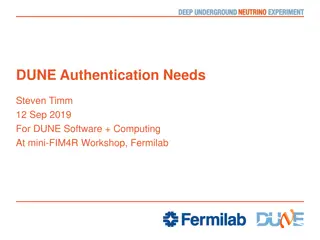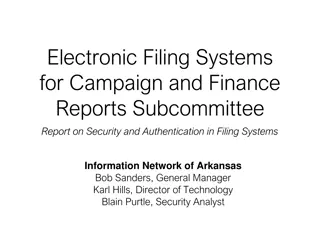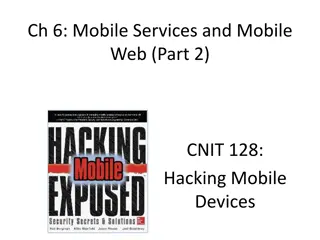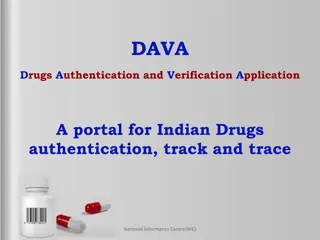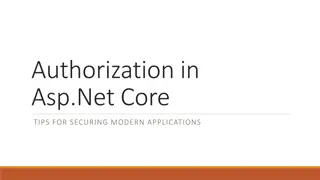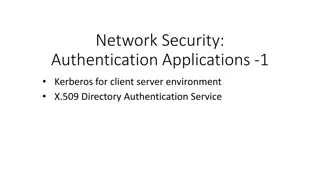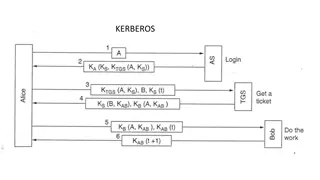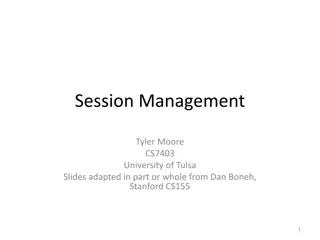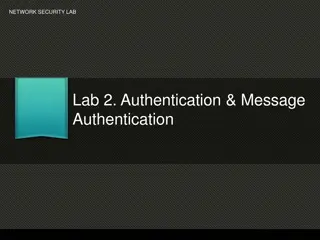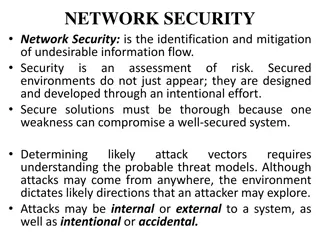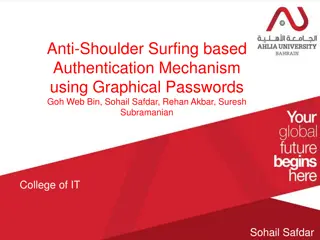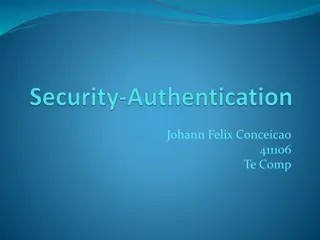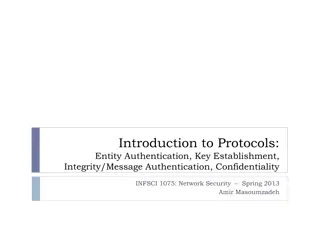Web Authentication and Authorization
Different authentication schemes such as Basic and OAuth 2.0, along with proxy authentication mechanisms. Delve into the complexities of securing modern web applications through federated interactions and the role of OAuth 2.0 in managing access to protected resources.
Download Presentation

Please find below an Image/Link to download the presentation.
The content on the website is provided AS IS for your information and personal use only. It may not be sold, licensed, or shared on other websites without obtaining consent from the author.If you encounter any issues during the download, it is possible that the publisher has removed the file from their server.
You are allowed to download the files provided on this website for personal or commercial use, subject to the condition that they are used lawfully. All files are the property of their respective owners.
The content on the website is provided AS IS for your information and personal use only. It may not be sold, licensed, or shared on other websites without obtaining consent from the author.
E N D
Presentation Transcript
Authentication and Authorisation COMP3220 Web Infrastructure Dr Nicholas Gibbins nmg@ecs.soton.ac.uk
HTTP authentication Simple authentication of user agent using HTTP headers Origin server sends WWW-Authenticate: header containing challenge (scheme and realm) User agent sends Authorization: header containing credentials Authentication schemes: Basic User agent sends base64( username + ":" + password ) Bearer OAuth 2.0 token 3
Basic authentication scheme GET / HTTP/1.1 Host: example.org HTTP/1.1 401 Unauthorized WWW-Authenticate: Basic realm="Access to Example" GET / HTTP/1.1 Host: example.org Authorization: Basic c3F1ZWFtaXNoOm9zc2lmcmFnZQo= HTTP/1.1 200 OK ... 4
Basic authentication scheme GET / HTTP/1.1 Host: example.org HTTP/1.1 401 Unauthorized WWW-Authenticate: Basic realm="Access to Example" GET / HTTP/1.1 Host: example.org Authorization: Basic bmV2ZXJnb2luZ3RvZ2l2ZTp5b3V1cAo= HTTP/1.1 403 Forbidden 5
Proxy authentication Similar challenge/response mechanism for authenticating with a proxy Proxy sends Proxy-Authenticate: header containing challenge User agent sends Proxy-Authorization: header containing credentials 6
Proxy authentication GET http://example.org/ HTTP/1.1 Host: example.org HTTP/1.1 407 Proxy Authentication Required Proxy-Authenticate: Basic realm="Access to Proxy" GET http://example.org/ HTTP/1.1 Host: example.org Proxy-Authorization: Basic c3F1ZWFtaXNoOm9zc2lmcmFnZQo= HTTP/1.1 200 OK ... 7
OAuth 2.0 Modern Web applications are federations of interacting services The password problem: how can we give an application access to our data held by a service (a "protected resource") without giving it our password for that service? This is a problem of authorisation, rather than simply authentication 8
OAuth 2.0 roles The resource owner An entity capable of granting access to a protected resource. May be a combination of a person (an end-user) and their user agent The resource server The server hosting the protected resources, capable of accepting and responding to protected resource requests using access tokens The client An application making protected resource requests on behalf of the resource owner and with its authorisation The authorisation server The server issuing access tokens to the client after successfully authenticating the resource owner and obtaining authorisation. 9
Abstract protocol flow obtain access token use access token delegate access 10
OAuth 2.0 protocol flows Authorisation Code Grant Client obtains access token directly from authorisation server ("3-legged") Flow relies on redirection via user agent Implicit Grant All communication goes through user agent ("2-legged") Commonly used by single page applications Resource Owner Password Credentials Grant Resource owner gives credentials to client (requires trust relationship) Client Credential Grant Client authenticates directly with authorisation server 11
Registration Client registers with the authorisation server before the protocol starts Client issued with a client_id unique string (not a secret) Client and authorisation server establish an authentication method Client password, use with HTTP Basic Authentication client_id, client_secret sent in request body (not recommended) Endpoints Authorisation endpoint (e.g. https://auth.org/auth ) Client redirection endpoint (e.g. https://client.org/cb ) Token endpoint (e.g. https://auth.org/token ) 12
Authorisation Code Grant 2. user authenticates 5. access token 4. authorisation code 6. resource access 1. authorisation request 3. authorisation code 13
1. authorisation request 1. authorisation request 3. authorisation code 3. authorisation code authorisation endpoint HTTP/1.1 302 Found Location: https://auth.org/auth? response_type=code& client_id=s6BhdRkqt3& redirect_uri=https://client.org/cb issued during registration redirection endpoint GET /auth?response_type=code&client_id=s6BhdRkqt3&redirect_uri= https%3A%2F%2Fclient%2Eorg%2Fcb HTTP/1.1 Host: auth.org authorisation code HTTP/1.1 302 Found Location: https://client.org/cb?code=SplxlOBeZQQYbYS6WxSbIA GET /cb?code=SplxlOBeZQQYbYS6WxSbIA HTTP/1.1 Host: client.org 14
4. authorisation code 5. access token agreed during registration POST /token HTTP/1.1 Host: auth.org Authorization: Basic czZCaGRSa3F0MzpnWDFmQmF0M2JW Content-Type: application/x-www-form-urlencoded grant_type=authorization_code& code=SplxlOBeZQQYbYS6WxSbIA& redirect_uri=https://client.org/cb authorisation code HTTP/1.1 200 OK Content-Type: application/json;charset=UTF-8 Cache-Control: no-store used to access resource { "access_token":"2YotnFZFEjr1zCsicMWpAA", "token_type":"bearer", "expires_in":3600, "refresh_token":"tGzv3JOkF0XG5Qx2TlKWIA" } used to get new access token 15
6. resource access access token GET /resource HTTP/1.1 Host: example.org Authorization: Bearer 2YotnFZFEjr1zCsicMWpAA HTTP/1.1 200 OK ... 16
4. refresh token 5. access token POST /token HTTP/1.1 Host: auth.org Authorization: Basic czZCaGRSa3F0MzpnWDFmQmF0M2JW Content-Type: application/x-www-form-urlencoded grant_type=refresh_token& refresh_token=tGzv3JOkF0XG5Qx2TlKWIA HTTP/1.1 200 OK Content-Type: application/json;charset=UTF-8 Cache-Control: no-store { "access_token":"2YotnFZFEjr1zCsicMWpAA", "token_type":"bearer", "expires_in":3600, "refresh_token":"tGzv3JOkF0XG5Qx2TlKWIA" } 17
Further reading Fielding, R. and Reschke, J. (2014) Hypertext Transfer Protocol (HTTP/1.1): Authentication. RFC7235. https://tools.ietf.org/html/rfc7235 Reschke, J. (2015) The 'Basic' HTTP authentication scheme. RFC7617. https://tools.ietf.org/html/rfc7617 Hardt, D. (2012) The OAuth 2.0 authorization framework. RFC6749. https://tools.ietf.org/html/rfc6749 Jones, M. and Hardt, D. (2012) The OAuth 2.0 Authorization Framework: Bearer Token Usage. RFC6750 https://tools.ietf.org/html/rfc6750 18


